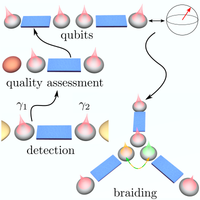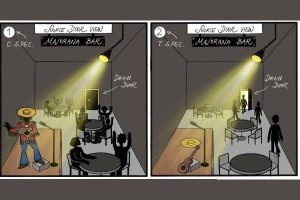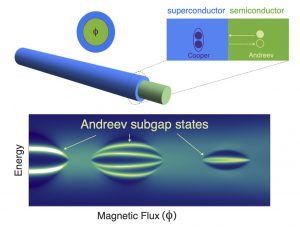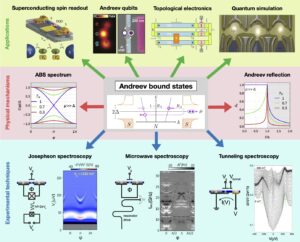PRB Letter ” “Thermodynamics of non-Hermitian Josephson junctions with exceptional points”, D. Michel Pino, Yigal Meir and Ramón Aguado https://journals.aps.org/prb/abstract/10.1103/PhysRevB.111.L140503

PRB Letter ” “Thermodynamics of non-Hermitian Josephson junctions with exceptional points”, D. Michel Pino, Yigal Meir and Ramón Aguado https://journals.aps.org/prb/abstract/10.1103/PhysRevB.111.L140503

https://journals.aps.org/prxquantum/abstract/10.1103/PRXQuantum.5.010323
 In this paper, Ruben Seoane and coworkers show how to demonstrate non-Abelian statistics with Majoranas created in minimal Kitaev chains based on quantum dots.
In this paper, Ruben Seoane and coworkers show how to demonstrate non-Abelian statistics with Majoranas created in minimal Kitaev chains based on quantum dots.

Majoranas are theoretical particles of great interest, as they are anticipated to show different exotic properties, including their applications in quantum computing. However, the jury is still out on whether these particles have been detected experimentally or not. In our collaborationwith scientists at the Institute of Science and Technology Austria (ISTA) and the Catalan Institute of Nanoscience and Nanotechnology (ICN2), we have discovered Majorana imposters by applying two measurement techniques, which will help to reduce interpretation uncertainties in the future search for these elusive particles. Our findings, based on new theoretical and experimental investigations, are published in Nature

Most experimental claims of Majorana bound states rest on the observation of a persistent zero bias peak (ZBP) in tunneling spectra. In our paper, we provide comprehensive evidence that the ZBPs observed in the experiments with semiconductor nanowires fully coated with a superconducting shell are not of Majorana origin. Instead, our theory demonstrates that ZBPs can be explained in terms of Yu-Shiba-Rusinov states (a special type of Andreev bound state) that originate in the tunneling region owing to the competition between electron correlations and superconductivity.
In this review, we discuss the main properties of Andreev and Majorana bound states, state-of-the-art techniques for their detection and theoretical progress beyond minimal models, including different types of robust zero modes that may emerge without a band-topological transition.

Check out Ramon’s recent invited perspective article in Applied Physics Letters on hybrid semiconductor-superconductor qubits.
